Through The Eye Of The Wind
Video of Gato Verde’s captain, Todd Shuster, teaching Beam Reach students how to sail on the Salish Sea.
Read MoreVideo of Gato Verde’s captain, Todd Shuster, teaching Beam Reach students how to sail on the Salish Sea.
Read MoreYesterday we got back from our two week session at sea. We had a rough start. Our first ten days were whale-less. Sure, J pod was around, but we always seemed to be in the wrong place at the wrong time. At one point we got a call that the whales were up in Active Pass. We couldn’t catch up to them, but we anchored strategically at Patos Island. That way, when they came through Active Pass we could see them if they went down either Boundary Pass or President’s Channel. To be sure that we didn’t miss them, we posted anchor watch that night. We each took two hour shifts listening to the hydrophone all night. I slept outside in hopes that I would hear their blows if they came by. None of us heard anything, so the next day we set ourselves up so that we had a view of everything. I got hoisted up onto the mast to have a better view of the surrounding water. We were there half the day before we heard that there were whales down south at Lime Kiln. Of course. They must have gone up Active Pass and then turned around and gone back the way they came, which they almost never do. We were six hours away, and by the time we made it down to Snug Harbor the whales had gone back out into the Strait of Juan de Fuca.
Our week continued like that until the Saturday before we got off the boat. We were headed out of Snug when Robin told me that she had seen a minke from the road on her way over. She figured that it’d be long gone, but I decided to go out and check anyway, just in case the whale had slowed down. I was out looking for no more than two minutes before Ally came out and asked what I was looking for. As I turned and told her, she suddenly pointed and said, “What’s that?” It was our whale!  As the whale arched its back, it was obvious that it was not a minke, but actually a humpback! Surprise #1! Another blow rose up and glistened in the sun. Surprise #2! There were actually two whales! It was exceptional. Humpbacks are rarely seen in Haro Strait, so it was a real treat. The local humpback population was destroyed by commercial whaling operations in the early 1900s. In fact, the whole Salish Sea population was wiped out in just one season of industrial whaling. They are only just starting to return a century later. We were lucky enough to get to observe two of these leviathons. I have had the opportunity to see a lot of humpbacks on whale watches on the East Coast, and they are always my favorite to see. They’re known for being extremely active and acrobatic. These whales did not disappoint. We were treated to just about every surface behavior imaginable. One whale breached, then performed a series of chin slaps before finishing with another breach. One of the whales slapped his pectorals repeatedly, giving us a beautiful display of his “big wings” that give humpbacks their Latin name (Megaptera novaeangliae translates to ‘big-winged New Englander’). It was fantastic. We also got some good looks at the flukes of the humpbacks. The markings on the undersides of the flukes are like a human’s fingerprint. The unique patterns and pigmentation are used to identify individual whales. For a catalog of the humpbacks that are seen in these waters, check out this site.
Just two days after this, we were performing a spreading and localization exercise when we got a text saying, “Many whales between False Bay and Lime Kiln.” When we spotted the first blows and fins I was incoherent with excitement (literally – Captain Todd had to ask me to calm down enough so that he could understand what I was saying). Finally, after three weeks of searching, J pod had come to us. It was amazing. The whales were extremely vocal, and we were the last boat with them, so we got some great recordings with minimal boat noise. We also witnessed a lot of surface active behaviors, including cartwheels, which was fantastic. We managed to remain with J pod for four hours. Even if it took us three weeks to find them, it was well worth the wait! I can’t wait to go back out and hopefully find them again!
Read MoreI’m happy to say we all survived 3 weeks at sea with many stories to tell! To the left is one of my favorite pictures taken so far of me and Mandy riding the waves on the trampoline along the bow of the catamaran! And yes it was cold…as you can see in my face. Before I jump too far into the 3 weeks, I’ll start by reviewing how a typical day is structured. We first get up around 7:00 a.m. every day with specific tasks. We each rotate around 4 different roles that help keep the boat in shape and organize our science activities for the day.The systems reporter measures the water level in our tank, updates the sewage level,checks the percent of biodeisel left in the tank, and records our engine run time. The navigator is responsible for the weather forecast ,strength and direction of the currents,direction of the wind, amount of time predicted to reach our destination ,and is responsible for directing the boat accordingly throughout the day.The University of Washington developed a useful online program called BIS Portal and we also use another source called Open CPN that helps us predict the timing of the currents. If you live close to shore or are interested, take a look at what the tides might be like! Here is the link to BIS Portal: http://bis_portal.apl.washington.edu/bis_portal_app.php. We also learned how to use a current atlas called the Washburn Tables that seemed to conflict multiple times with Open CPN and Bis Portal predictions. This conflict further proves the complexity behind our ocean’s dynamics! Especially within the San Juan Islands where currents have hundreds of obstacles compared to deeper ocean waters away from the coast.
The science lead has the most work out of all the roles. This person is in charge of all the science activities and helps individuals reach their particular goals. The science reporter is the person who was science lead the day before and recaps what was achieved previously through graphs or a narrative presented in front of the crew. After a science meeting presenting each update, we cast off for the day.One topic that is always on our minds no matter what our science goals are for the day is the presence of whales! If we hear that whales are around we make finding them our number one priority!
We are also learning how to efficiently stay warm without putting on too many layers and making it impossible to move. Even though its Spring its very cold on the boat, especially at night in our cabins. I think this trip will make us all appreciate  how much is readily available to us on land on a daily basis (including a heater) and be more aware of how much energy and water we are using without thinking about it! This sustainability awareness is presented in the name of our catamaran. Our captain, Todd Shuster, named his catamaran the Gato Verde. 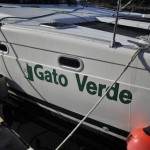 This translates to the Green Cat in spanish. It is “green” because it practices sustainable methods and “cat” represents the fact it is a catamaran. Our class revolves around practicing sustainability when we clean using environementally friendly cleaning materials and methods,minimize water usage, run the boat with biodiesel, and use the sails as our source of speed when wind is present. This class is already making me more conscious of my actions and keeping me more organized compared to how I used to be!
This translates to the Green Cat in spanish. It is “green” because it practices sustainable methods and “cat” represents the fact it is a catamaran. Our class revolves around practicing sustainability when we clean using environementally friendly cleaning materials and methods,minimize water usage, run the boat with biodiesel, and use the sails as our source of speed when wind is present. This class is already making me more conscious of my actions and keeping me more organized compared to how I used to be!
Living in my Northface fleece
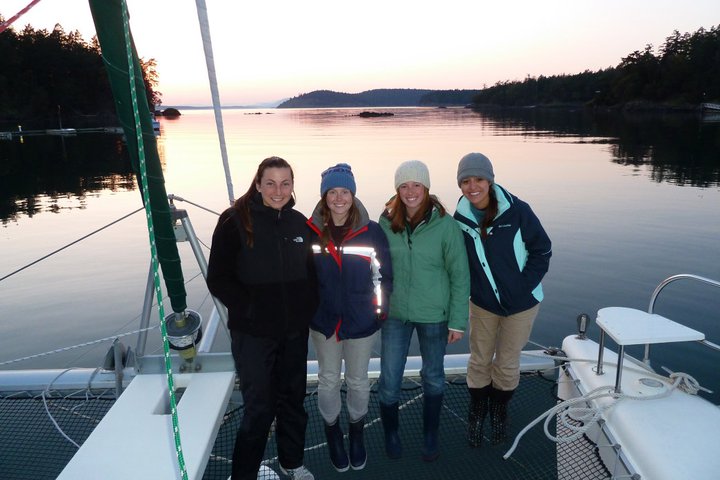
We were all so excited to get on the boat. We planned to meet Captain Todd at 11:45 on Sunday to load our gear and begin our high seas adventure. It was a beautiful sunny day. We loaded all our gear and set sail. Todd decided to take us to the infamous Cattle Pass, which is known for its wildlife. On the way there we all sat on the trampoline and watched the water pass underneath our feet. At Cattle Pass we saw some Stellar seals hauled out on a rock and a bald eagle. As darkness descended upon us, we made our way to McKay Harbor where we moored the boat for the night. Sleeping on the boat was colder than I expected it would be. I wore a lot of layers to bed, but I was warm.
To keep the boat in ship shape and stay organized, we are assigned different jobs that we rotate through every day. On Monday, my job was to be the navigator. Being the navigator, I was in charge of charting our course. This is a cool job that involves looking at all the charts with a divider, I felt pretty nautical. I had to listen to the weather report on the radio and check the tide and current books to see where we should go and when. There were no reported sightings of orcas in the area, but there was a sighting of gray whales in Saratoga Pass, which unfortunately was pretty far from where we were. I chose to go north to Sung Harbor and we got our Gato Verde introduction on the way.
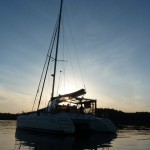
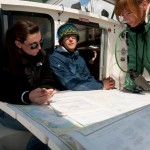
On Tuesday we made our way south to Port Townsend, because there were reports of transients south of Whidbey Island. We wanted to be wherever the orcas were. I was the science lead, so I was in charge of keeping everyone organized and outlining the priorities for the day. On the way, we deployed our precious hydrophone array and recorded some sounds so we could practice analyzing the sound files. The hydrophone array is a big deal because that’s how we record the whales. We have a line of 4 hydrophones spaced our across 10m increments that we tow behind the boat. We docked our boat in Port Townsend for the night. The dock had a Marine Science Center on it with all sorts of cool tide pools and aquariums. That night on the boat was also cold. I slept in many layers again. At this point it dawned on me that I was probably going to be spending my week in many layers.
Wednesday I was the systems reporter. To do this job I checked our water and sewage levels and biodiesel supply. I entered the levels into the computer and reported the daily water use per person, so we could keep track of our water use. Mandy was the navigator and she, like all of us, was on a mission to find whales and with no orcas in the area, we turned to the gray whales. We charted a 10 hour cruise up around Whidbey Island ending at Penn Cove. It was awesome. We sailed all day and it was a gorgeous sunny day. Mandy, Emalie, and I rode the bow all day and kept our eyes peeled for whales. Around lunch we saw something amazing. Val spotted a breaching Minke whale! These whales rarely jump out of the water and this one breached 5 times! It was really cool. It caught us all by surprise, so we only got 1 photo. Val was quick enough to get a shot of its little dorsal fin. We reported our sighting to Orca Network. Due to our lack of credibility and rarity for Minkes to breach, they reported “beam reach students reported what they believed to be a Minke Whaleâ€. Taken back by their lack in confidence in our sighting, we compiled a case, sent in our Minke fin picture and earned some street cred. Check out Mandy’s post dedicated to whale identification here. We also saw many porpoises. They were really cute. As we continued around Whidbey, it became clear that we wouldn’t make it to Penn Cove before dusk. As we realized this, we got a call that there were gray whales in our area. No sooner had we looked to the horizon when blows were spotted. We quickly decided to anchor in a closer location, Elgar Bay , so we could spend the rest of our afternoon with the gray whale. We watched as it was feeding and recorded the time between its breaths. It was such a fun day!
Since we hadn’t gotten as far as we planned on Wednesday we had to get up extra early on Thursday to time the current leaving Deception Pass. Deception Pass, as I will explain, was one of the coolest parts of the trip. My job Thursday was to be the science reporter and report on what we did the day before. Scott helped me make a graph of the gray whale breath times from the day before. From my graph we found a dive pattern. It was really neat. Going through Deception Pass was so beautiful. It is an extremely narrow channel and it was possibly the most beautiful thing I have seen in the San Juans so far. We anchored in Aleck Bay early in the afternoon so Mandy could do a sound spreading exercise for her project. We sent Scott, Robin, Mandy, and Kelsey out on Gatito, the dingy to play sounds from different distances. Emalie and I recorded the data from the sound on the boat and enjoyed the beautiful day.
Friday we spent out day traveling north to Snug Harbor. One the way we did a lot of science. We stopped for a while in Salmon Bank and took samples for Kelsey’s project. Again, it was an amazing day and spending it out on the water made it all the better. We also deployed the most expensive piece of science technology on the boat, the CTD. The CTD is a device that can measure nearly everything possible to measure in the water. It records the temperature, salinity, chlorophyll levels, light particles, pH, and oxygen levels. We tied two “oh crap lines†aka back up lines to that device.
On Saturday we had a guest speaker, Jessica Lundin come and talk to us about her work of gathering and analyzing orca scat samples. That was really interesting. We spent the rest of the day gathering plankton samples and deploying the CTD offshore from Lime Kiln State Park. As we needed more water and a place to pump out the sewage, we headed to Roche Harbor. Roche harbor is a very interesting place. It was hands-down the nicest port we had stayed in, having giant yachts and sea planes all over. It was such a warm day I was down to 1 layer, it was very exciting. After dinner, Mandy and I wandered the town and visited a sculpture garden. This was the most elaborate sculpture garden I have ever seen, we were there admiring and wandering for 2 hours. Later that night when we were working we heard J-Pod on the hydrophone! Sweet irony. We spent a week at sea hoping to see J-Pod and they come back the night of our last day at sea. At least they’re back.
On Sunday, we unloaded the boat and we’re welcomed home with an Easter brunch from Leslie and Val. It was so sweet of them. They even hid chocolate eggs all over the house for us. It was a great way to end a great week.
Read MoreFor the past two weeks our lectures on how people affect the marine ecosystem have changed my perspective on awareness of sustainability practices. Living in Bellingham, Washington for the past 5 years has opened my eyes to some sustainable practices such as ‘green building’ where homes and any other city building are built to be energy efficient. This efficiency is achieved by the use of solar heat instead of electric heat, and the design is made to control loss of air, heat, and moisture. Bellingham also offers organic food products at most of the grocery stores that come from nearby organic farms. Great practices such as organic delivery bins are encouraged where fresh organic fruits and vegetables from local organic farms are delivered right to your door. For people who usually rely on their car, the delivery bins allow it so no fuel is wasted and organic farms are supported. You can check out their mission at http://www.dandelionorganic.com/about.htm. It seems to me that their business should be mimicked by others in as many places as possible!
Recently we also had the opportunity to contribute to a 20 acre organic farm called Sweet Earth Farm on San Juan Island. Here is a picture of us removing the weeds that were suffocating the orchard! 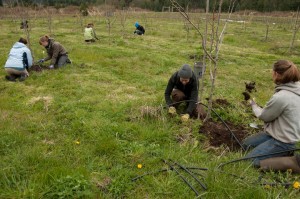 We learned about how they avoid using nonrenewable resources, chemicals and other artificial substances in order to efficiently grow their crops. It got even more interesting when the owner would tell us about other organic farmers that have made 100’s of people food from just a small acre of land using permaculture practices. Permaculture is a sustainable land use design that is based on natural ecology. This design uses what is available in nature in order to maximize the use of the land, minimize the work needed to maintain it, and restore the environment. At first I speculated whether or not this method could actually supply a large sum of people enough food for a few months. She made me more of a believer by sharing more stories of other farmers who have been successful in this field of agriculture. Supposedly in Paris a small plot of land using the permaculture design was able feed the whole city! How amazing is that? I can’t recall the name book that claimed this incredible story as true, but if you want proof I could go back and find out! This made me even more interested in her farm and way of living. It seemed so different from the norm and exactly the way farming should be. She also made her own ointments, lotions and tea from an herbal garden next to her house. All of these self sustainable practices definitely sparked my own thoughts about creating an organic garden that I could live off of and be comforted by the fact I would be contributing to instead of harming the environment.
We learned about how they avoid using nonrenewable resources, chemicals and other artificial substances in order to efficiently grow their crops. It got even more interesting when the owner would tell us about other organic farmers that have made 100’s of people food from just a small acre of land using permaculture practices. Permaculture is a sustainable land use design that is based on natural ecology. This design uses what is available in nature in order to maximize the use of the land, minimize the work needed to maintain it, and restore the environment. At first I speculated whether or not this method could actually supply a large sum of people enough food for a few months. She made me more of a believer by sharing more stories of other farmers who have been successful in this field of agriculture. Supposedly in Paris a small plot of land using the permaculture design was able feed the whole city! How amazing is that? I can’t recall the name book that claimed this incredible story as true, but if you want proof I could go back and find out! This made me even more interested in her farm and way of living. It seemed so different from the norm and exactly the way farming should be. She also made her own ointments, lotions and tea from an herbal garden next to her house. All of these self sustainable practices definitely sparked my own thoughts about creating an organic garden that I could live off of and be comforted by the fact I would be contributing to instead of harming the environment.
Our last lecture before voyaging out to sea on the catamaran was presented by Val Veirs and David Bain on the effects of cars on killer whales. Who knew that there is actually a strong link between the two? One of the reasons cars harm the whales is by the construction of roads. Roads typically are built to get people from one place to another, without thinking of what could be destructive to the surrounding marine life. How exactly do roads harm surrounding marine waters? Roadways that are built around streams create a larger impervious service. This service includes cement parking lots, crowded neighborhoods and anything that will decrease the soil band around streams. This soil is vital to the health of  streams because it is needed to filter the incoming water from these impervious services that sometimes contain waste, chemicals, and/or fossil fuels that leak from cars. The San Juan Islands in particular are known to have a very thin layer of soil, creating an inefficient filter system on the land. This filter system is important for the health of marine animals because anything that filters into the stream is brought to the ocean, where it is consumed by the fish that are eaten by the whales. People tend ignore the fact we live around a complex marine ecosystem that is sensitive to changes.  Another reason cars are harmful to killer whales is by the construction of low bridges that are built in places where the orcas typically travel through. An example of this situation was when the Hood Canal bridge was reopened in 2009.  It just so happens that around the time it was reopened the orcas started avoiding this passage. There aren’t many cases where bridges have this effect on the whales, but there are many accounts of fossil fuels contaminating marine waters. It is apparent that people need to raise awareness on the harmful effects of fossil fuels on the marine ecosystem so that alternative fuel options can be popularized!
Read MoreDo you ever think about where your food comes from? I don’t mean the supermarket versus the local farmers market…I mean where it REALLY comes from. For instance, did it grow on a tree in an orchard or root itself deep in the soil? I imagine most my age and older could easily tell you where most basic fruit and vegetables come from. Can we say the same about the generation entering third grade? Do they know that corn comes on a cob tightly packed in neat rows? How about that it is cushioned by fine silk like hairs and wrapped in blade shaped leaves? Do they know that this unit is called an ear?
I often wonder how many people have been to a farm and seen how much work goes into each plant to get a piece of fruit. As a farmer you hope that your hard work brings large yields. There are many factors that contribute to yield. It begins with picking the piece of land and thinking about what you may want to plant there. Water availability, access to the sun, and whether it is a forest or grassland are all great things to consider. However, the soil is really the most important, both in quality and quantity. The soil has to be loose enough for roots to penetrate, while holding in appropriate amounts of moisture without eroding away.
A visit to Sweet Earth Farm on San Juan Island got us down and dirty working directly with the soil. We talked about what it means to be organic and the different variations it encompasses. Large scale industrial farming uses  herbicides and pesticides while organic farms do not. You are probably thinking aren’t you looking for whales? You don’t need to be a researcher to know they don’t sprout out of the ground. (Although that would make our job a lot easier!)  So, how does a farm fit in?  Well as a great philosopher of my childhood once said, we are all connected in the circle of life.    Lion King – Circle of Life
It is true in this case too. Those chemicals used on farms may be directly sprayed onto the crops. Some may go into the air, but eventually it all settles into the soil when the plants decompose. The soil acts as a natural filter, but many times those compounds sneak through. This happens when the soil depth is not great enough to allow for proper filtration.  After passing through the soil, these herbicides and pesticides go into the ground water. This water and its contaminants may feed a stream or lake that is a water source for the local town, but can also go from those rivers into the ocean.  In areas where farming happens along the coast, water can run directly off the soil into the surrounding ocean environment.  Now these chemicals are coming into contact with our beloved whales and their food.  (For more on what is invading their environment click here.)
Sweet Earth’s land is still fairly wet at this point in the year, so most of the planting still needs to be done. The orchard however is there year round through all the elements of the seasons. It was our job to cut back grass and weeds around the base of the tree. We were attempting to clear out the soil around the tree roots to give them space to grow. Most of the weeds require complete removal of the roots, so we did our best. Moving the dirt around you could see all the content creepy crawlies. They too live off the soil. Actually, they make the soil by aiding in the break down of the organic (plant) matter that falls into their surroundings. All of these small parts make the soil rich and fertile. The quantity issue is a little harder to address on the island because most top soil is less than a foot deep. Over the years, much has likely drifted off the banks and down to the ocean floor. Without trying to dig that up, a way to increase soil depth is to add more organic matter. Sweet Earth adds a mixture of compost and manure to increase both quantity and quality.
Looking back, one of my first dinner conversations with Mandy was the lack of a compost bin in the Dining Hall at the Friday Harbor Labs. Often after a meal, food scraps were left on our plates. Regardless of why they were left, they all ended up in a trash can next to the rack for dishes and trays. Compostable cups available for drinks through out the day are also put into the trash. Those can cost about 10 cents more than similar cups (see compostable cups versus regular cups).  Think back to when you were a kid, your parents may have said you needed to finish all of your food because there were starving children in some other part of the world. It is not realistic to ship the food to them, but it doesn’t have to go into the trash. Try composting!  Afterall… It is a great way to turn those left overs into something useful.  Plus, you can see if those Sun Chip bags really do compost or how long it takes until a compostable cup becomes unrecognizable.  Even if you don’t garden, you can find a local gardener or farmer who would appreciate your compost pile.  Sweet Earth said they could definitely use more compost, so if you are local you could donate there. If not, ask around. You will likely find a place in need. Some cities even have large scale compostable options (http://www.findacomposter.com/index.php).  Here are a few sites to get you started.
It is a great way to turn those left overs into something useful.  Plus, you can see if those Sun Chip bags really do compost or how long it takes until a compostable cup becomes unrecognizable.  Even if you don’t garden, you can find a local gardener or farmer who would appreciate your compost pile.  Sweet Earth said they could definitely use more compost, so if you are local you could donate there. If not, ask around. You will likely find a place in need. Some cities even have large scale compostable options (http://www.findacomposter.com/index.php).  Here are a few sites to get you started.
http://compostguide.com/composting-tips/
http://www.sunchips.com/resources/pdf/SunChips_compost.pdf
http://www.urbangardencenter.com/composting-guide/composting-guide.pdf
http://www.plantea.com/compost-materials.htm
Once you get your first batch of usable rich soil, you may want to start gardening just so you can use it.
Happy composting and growing,
~Emalie
Read MoreYesterday we returned from our first week at sea on the Gato Verde! It was an absolutely fantastic week, even though the orcas managed to elude us. We went where no Beam Reach group has gone before: all the way around Whidbey Island via Saratoga Passage and through the narrow, turbulent Deception Pass! In case you didn’t know, Whidbey Island is BIG! In fact, it’s the largest island in the state of Washington, and the fourth largest in the lower 48 states. It took us several full days of cruising and a 5:30 AM hail-and-rain-filled departure from anchorage to make it all the way around.
However, we got an incredible taste of the marine life of the Salish Sea. We were treated to sights of river otters, harbor seals, California sea lions, Stellar sea lions, harbor porpoises, gray whales, and even an elusive minke whale! After shooting through Deception Pass, we surprised a California sea lion, who popped up right in front of our boat and proceeded to glare us down for the intrusion. We got to watch a gray whale slowly feeding up and down the coastline. Our first cetacean encounter of the trip was of a minke whale breaching at least five times in quick succession in Admiralty Inlet. I have seen a lot of minkes on various whale watching trips on the East Coast. Usually they just pop up a few times and then disappear. I have NEVER seen one breach. This was most certainly the highlight of the trip for me so far.
However, we were confronted with a problem when reporting the minke whale. No one believed us. It turns out a humpback whale was also sighted breaching that day in about the same area. As breaching is much more commonly observed in humpbacks than in minke whales, everyone assumed that we had mixed the two up and had actually seen the humpback. If Val hadn’t been quick and snapped a picture of the dorsal fin, most likely no one would have believed us. It turns out that this is a common problem. Seeing as how we usually only get to see such small parts of the whales above the water, it is very easy to get the different species confused. I decided to compile a quick guide of some of the more commonly sighted species of cetaceans in the Salish Sea in an effort to make it easier to properly identify these species when spotted! Below is a diagram of a humpback whale. Some key features that I will be discussing are labeled. All photos are taken by me unless otherwise labeled.
CETACEAN 101
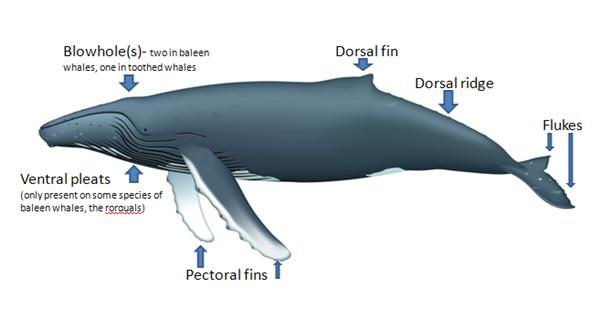 A) The Mysticeti, or baleen whales.
A) The Mysticeti, or baleen whales.
1. Minke Whale– The minke is the smallest of the baleen whales. They are roughly the size of an orca, and are dwarfed by the larger gray whales and humpback whales. Being so small, their blows are not always easily seen. Their bodies are small and torpedo-like, with small pectoral fins with a white band going across them. If you are lucky enough to see them breach, as we did, you can easily see this.
Note the smooth, torpedo-like shape. The white band on the pectoral fins is clearly visible, and the small pectorals are tucked in close to the body. The minke whale is part of the rorquals, so they do have ventral pleats. However, you have to be quite close to be able to distinguish these pleats.
Breaching is a rare thing to see in a minke; they are typically shy and elusive, so more frequently you only see their back and dorsal fin. No fear though, as the minke dorsal fin is also fairly easy to distinguish from other cetaceans in the Salish Sea. As with all baleen whales, the dorsal sits about 2/3 of the way back on the body, so it is preceded by a fair amount of back before the dorsal fin can be seen. The dorsal is small and distinctively curved.
Another thing to look for in minkes is lunging behavior. These whales often lunge feed; they create a bait ball and then lunge through the middle and can sometimes come partly out of the water. Minke whales are perhaps easiest to confuse with fin whales. While these guys are rare visitors to the Salish Sea, it is still worth noting the difference, as they are sometimes seen here. Fins also have small, hooked dorsals that look quite similar to minkes. However, the fin whale tops out at around 80 feet, and is the second largest creature on earth. This is much bigger than the 30 foot minke. While it can be tricky to distinguish from a distance, size is the key feature to look for in this case.
Minke whales are known to make “boing” sounds. Most of the energy in these calls is between 1 and 2 kHz, which is well within the hearing range of humans. An example of their call can be heard here.
2. Humpback Whale– Humpbacks are larger (between 40-50 feet) members of the baleen whale family. When you know what you are looking for, humpbacks are pretty easy to distinguish from other species of cetaceans. Their blow is usually more visible than the blow of a minke. See the picture below to note what to look for in the blow.
Humpbacks are also known for being one of most acrobatic of the whales. They frequently breach, spy hop, slap their pectorals, and slap their flukes. If you see a whale doing any of these behaviors, look closely. The most obvious feature of the humpback whale is its pectoral fins. Their scientific name, Megaptera novaeangliae, literally means “large-winged New Englander.” Long and often white, the pectorals are very obvious and are a dead giveaway that you are looking at a humpback.
Humpback whales are also known to fluke, which is when they deep dive and show their tails. All the whales have distinct white patterns on the underside of their flukes. These patterns are used to identify individual whales. Minke whales do not usually show their flukes. Gray whales do on occasion, but humpback whale tails are distinct in shape.
If you only see the dorsal fin of the whale in question, it is also fairly easy to tell which kind of whale it is, especially if you get a picture! Humpback dorsal fins have a small bump in the front and then a sickle-shaped curve. They are also well-known for “humping” their backs right before they dive.
Humpbacks are known for being very vocal, and males compose long, haunting songs that carry for miles. An example of a humpback song can be found here. However, these songs are sung primarily at the breeding grounds of humpbacks, presumably to attract mates, although this isn’t known for sure. Humpbacks found in the Salish Sea are more likely to be making a feeding call.
3. Gray Whale– Gray whales are rather prehistoric looking whales that can be found in the spring, summer and fall in the Salish Sea. These whales like to feed along the bottom in shallow waters, and so are frequently seen foraging close to shore. They are covered in barnacles and whale lice. These patches of parasites can help distinguish individuals.  The blows of gray whales are bushy and heart-shaped.
Gray whales also don’t have a dorsal fin, instead they have a prominent dorsal ridge.
Gray whales tend to roll on their side and scrape along the muddy bottom in search of food. Because they feed in shallow water, this often exposes their pectoral fin. They also sometimes show their flukes, which are smaller and more square-shaped than those of humpbacks.
If you wish to try to identify a gray whale that you spotted, check out the gray whale ID guide from Cascadia Research Collective.
The vocalizations of gray whales are typically series of grunts. The average frequency is typically around or below 1 kHz.
A quick comparison of these three most common species of baleen whales found in the Salish Sea:
B. The Odontoceti, or toothed whales
1. Killer Whale, or orca- The orca is the most easily distinguished cetacean in the Salish Sea. Actually the largest member of the Dolphin family, the orca can be recognized by it’s black and white color pattern. Males sport dorsal fins up to six feet tall, while females have smaller, curved dorsal fins. The gray saddle patch behind the dorsal fin can be used to identify individual killer whales.
Of the three ecotypes of killer whales (residents, transients, and offshores), only residents and transients are found with any regularity in the waters of the Salish Sea. While it can be difficult to distinguish these two, it is not impossible. The southern residents (SRKWs) are found in relatively large, stable family pods, while transients are typically (but not always) found in smaller pods. Of course, the SRKWs eat only fish, while the transients prey on marine mammals. So if you see a killer whale pursuing a sea lion or other mammal, it is a transient. Transients and residents can also be distinguished by their dorsal fins and saddle patches. The SRKWs have more rounded dorsal fins than transients, and they can have open saddle patches, while the transients have solid gray saddle patches. Residents and transients can also be distinguished by their calls. Residents are much more vocal, and tend to have an almost up-beat, bubbly sound to their calls. Transients typically make fewer vocalizations that have a rather haunting quality to them.
2. Pacific White-sided Dolphin- While Pacific white-sided dolphins aren’t seen frequently in the Salish Sea, they are seen at times during the summer and fall. These dolphins are relatively small, around eight feet long. They have a dark upper body, with a light underside and gray stripes running along their sides. They also tend to show more of their bodies when surfacing than the porpoise species found in the Salish Sea. They make high frequency, whistle-like vocalizations.
3. Harbor Porpoise- Harbor porpoises are small members of the Phocoenidae family. They are gray-brown on top with a light underside. They have a triangular fin. Harbor porpoises are often seen in fairly shallow water, and can be found around the mouths of rivers. They are typically found in small groups of less than ten individuals. Harbor porpoises typically make acoustic signals that are above the hearing range of humans, but it is possible to slow the calls down to allow humans to hear them.
4. Dall’s Porpoise- Dall’s porpoises have a black and white coloration that is similar to that of orcas, leading to them occasionally being incorrectly referred to as baby orcas. Measuring around 6 feet, the lack of an eye patch and shape of the dorsal fin immediately give the animal away as being a Dall’s porpoise rather than an orca. Dall’s porpoise are very fast cetaceans, and often create a “rooster tail” of spray when bow-riding. They have a small white patch on their triangular dorsal fin, helping to distinguish them from harbor porpoises. They are stockier than harbor porpoises, with a narrow, distinct peduncle (area immediately in front of tail). Like harbor porpoises, Dall’s porpoise produce acoustic signals that are too high for most humans to hear. However, when brought down to a frequency within our hearing range, they make a series of click-like sounds. Scripps Whale Acoustic Lab has a nice recording of a Dall’s porpoise here (For whatever reason I can’t link directly to it, so click on Porpoises, Dall’s porpoise, and then play call).
Comparison of toothed whales found in the Salish Sea:
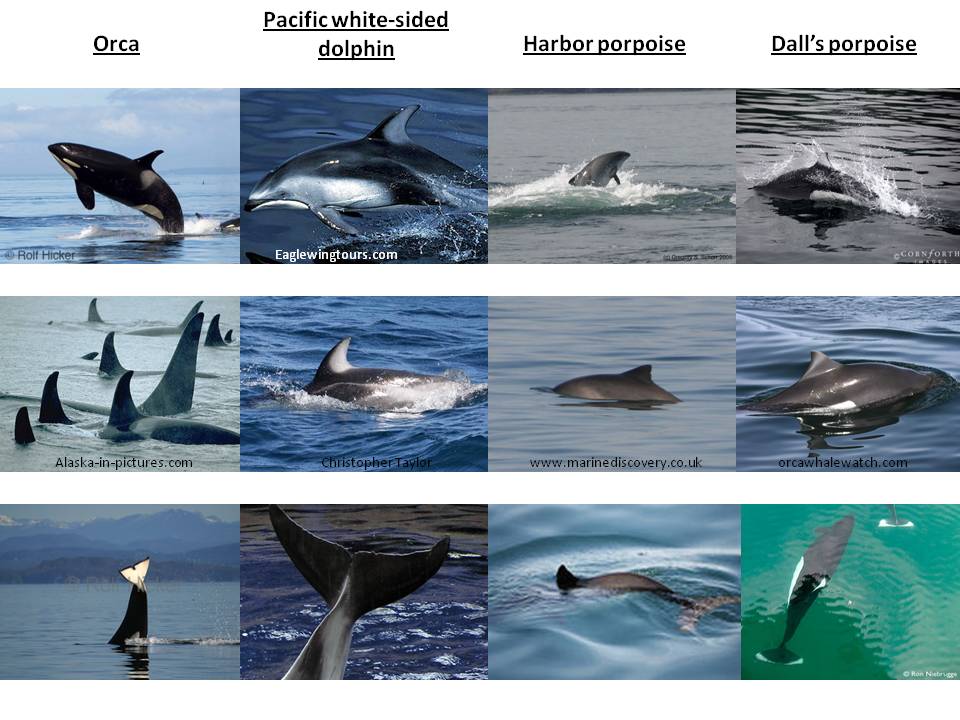 Well that about wraps it up for the cetaceans of the Salish Sea! I hope that this helps provide a guide for identification of the cetaceans in this area.
Well that about wraps it up for the cetaceans of the Salish Sea! I hope that this helps provide a guide for identification of the cetaceans in this area.
On a quick side note, I would like to thank everyone who was on the Gato Verde with us this past week, and give a special thanks to Val and Leslie for cooking us a fantastic Easter brunch and letting the Easter Bunny into S1 to hide chocolate eggs for all of us! 🙂
Also, while writing this blog post, I was interrupted by orca calls on the Lime Kiln hydrophones. Carlos was super nice and drove us all down to Lime Kiln, where we got our first sighting of J Pod!!! It was extremely exciting, probably one of the best days of my life. One whale even breached right off shore from us twice! I’d like to leave you all with this photo of a whale porpoising by us at LK. Jeanne was also watching from shore; she got some IDs and posted a recording of the calls on her blog!


“What are the effects of cars on whales?” This week, we were all asked this question by the extremely knowledgeable killer whale researcher Dave Bain. We all sat there, staring blankly and not coming up with any potential impacts. We could think of nothing. However, it turns out cars are one of the top threats to the marine mammals. Everything from oil spills, to abundance of prey, to threats to the whales from alternative energy are influenced by them.
It’s a theme that we’ve been learning a lot about in the past couple weeks. Our terrestrial environment has remarkable
effects on the marine ecosystems. It’s something that isn’t thought of that much, with the exception of direct dumping into the environment and potential contamination of groundwater. But it is a concept that deserves more attention. This terrestrial impact has been the focus of our service projects this year, and rightfully so. Last week, we helped work on the enhancement and restoration of Beaverton Marsh. Over the years, the invasive reed canary grass has taken over the wetland, which has fallen victim to agricultural overuse. The restoration project aims to help restore native species and increase the diversity of the marsh. So for a couple of hours we all sloshed around in the mud and put plant protectors and mulch on plants that had been previously planted. It was hard work, but well worth the effort. Plus, it was a GORGEOUS day, which made it very enjoyable!
Last Friday we spent the day helping out on an organic local farm. We toured the farm and learned
a bit about organic farming on the island. We talked about permaculture, which is a type of agriculture that tries to model natural processes in nature. For example, there is a heavy focus on the use of perennial plants over annual plants (which need to be planted every year). The majority of plants found in the wild are perennials, which have a very stable root system. These long, deep roots absorb nutrients more efficiently, and so generally require less maintenance than annuals, and don’t deplete the topsoil as much. For more information on the use of perennials vs. annuals, check out this article from National Geographic.
Now you might be wondering what all of this really has to do with whales. It turns out, a lot! The three main threats to the southern resident killer whales were listed as being: 1) Prey availability, 2) Vessel noise, and 3) Toxins. The terrestrial environment can have a large effect on both prey availability and toxins. Degradation of the spawning environments of Chinook salmon can limit the returns of the fish back to the ocean. These rivers are easily affected by humans and agriculture. Cattle and other livestock can erode the river and stream banks and the removal of riparian vegetation leads to decreased shelter from predators (provided by shade) and increased temperatures that could rise to undesirable levels for the cold-loving salmon. Agricultural runoff creates an influx of nutrients that can lead to eutrophication and decreased oxygen content in water bodies. Dams create barriers to salmon migration to spawning areas. All of these lead to less fish for the killer whales to eat.
Toxins also pose a huge threat to the killer whales. High on the trophic pyramid, the killer whales suffer from the bioaccumulation of chemicals (see diagram at right). High levels of DDT, PCBs, and PBDEs have been found in killer whales. These are all organic chemicals that don’t breakdown well, leading to relatively high levels in the mari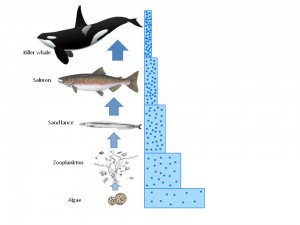 ne environment, even for the now illegal DDT. Indeed, many pesticides are a problem. Kwiaht in 2008 found that pyrethroid pesticide levels in the San Juan County waters averaged 1-2 parts per billion, with much higher levels in some areas. Levels of 1 part per billion are known to be toxic to salmonids. Surfactants, which are chemicals used to mix water and oil, are present in nearly every man-made product. The Friday Harbor Aquarium found lethal levels of surfactants in the surrounding water.
ne environment, even for the now illegal DDT. Indeed, many pesticides are a problem. Kwiaht in 2008 found that pyrethroid pesticide levels in the San Juan County waters averaged 1-2 parts per billion, with much higher levels in some areas. Levels of 1 part per billion are known to be toxic to salmonids. Surfactants, which are chemicals used to mix water and oil, are present in nearly every man-made product. The Friday Harbor Aquarium found lethal levels of surfactants in the surrounding water.
All of these toxins come from the terrestrial environment. It is important to be conscious of what we’re pouring down the drain or dumping outside. The San Juan Islands were heavily glaciated in the last ice age, which has resulted in very thin soils in many areas. Soil typically helps to filter groundwater. This decreased filtration can lead to increased runoff of chemicals to the marine environment. It’s important to be conscious of what we’re pouring down the drain or dumping outside. Try to minimize the amount of chemicals poured down the drain. Take care of your septic system to help prevent leakage. Restoration projects help bring back native species which help balance the ecosystem. Sustainable agricultural processes help reduce the runoff of toxic pesticides and other chemicals. So be cautious, be aware, and help protect these iconic animals!
Read More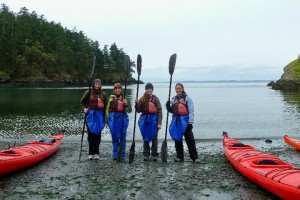
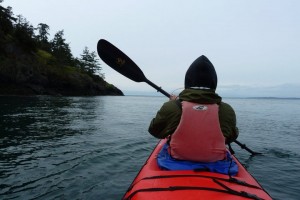
On Sunday Robin took us on a kayaking excursion along the coastline. We got up bright and early to meet her and then we all drove to the San Juan County Park to launch our kayaks into Smallpox Bay. We got a brief introduction to kayaking and then put on our “spray skirts” and headed out. We were in tandem kayaks, Mandy and I were in one, and Emalie and Kelsey in the other. Mandy, sitting in the back, was in charge of steering and did a great job in steering us close (but not too close) to the rocks to see the interesting organisms. We saw many purple pisaster starfish. Robin even found a gumboot chiton and gently plucked it from the rocks to show us. It looked like a giant red slug with a hard shell. As we made our way along the coast the wind began to pick up. We also saw some juvenile bald eagles fighting over the remains of a crab. Being from San Diego, I haven’t seen many bald eagles, and boy, are they huge. After seeing an eagle, Â I was inspired to learn a bit more about these majestic birds.
Robin also arranged for us to go help her friend, Doug Mcutchen of the San Juan County Land Bank, restore the Beaverton Valley Marsh. Presently, the wetland is overrun by non-native reed canarygrass which outcompetes the natural plant species. Earlier volunteers planted native plants such as gooseberry, willow, and black hawthorn along the margins of the wetlands. By planting natural species, they hoped to improve the wetlands diversity and enhance its habitat value for birds and other animals. Our goal was to aid the pre-planted natural species, black hawthorn, gooseberry, and willow, in hopes that they would grow to be healthy and shade out the invasive grass. It was a beautiful sunny day so we were all thrilled to be outside helping the environment.
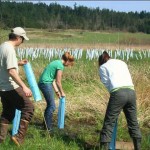 We began our restoration by putting white plastic tubes around the important native plants to shelter and protect them from foraging deer and voles. We then put cardboard around the base and mulch on top to give the plants nutrients and a stable start. I thoroughly enjoyed being outside in the sun all day. We even saw some spring peepers, which are cute little green frogs.
We began our restoration by putting white plastic tubes around the important native plants to shelter and protect them from foraging deer and voles. We then put cardboard around the base and mulch on top to give the plants nutrients and a stable start. I thoroughly enjoyed being outside in the sun all day. We even saw some spring peepers, which are cute little green frogs.
There is an abundance of wildlife living in this area. I have seen black and red foxes running all over, and they are adorable. Mandy was quick enough to get some photos of the black one.
On Saturday before we went on the boat, we made a trip out to Lopez Island for the day. Since downtown Lopez is small, we had time to go into every store . While Kelsey  interviewed for a summer job, we got ice-cream and ate it on the beach.
Read MoreIn the end, we will conserve only what we love,
we will love only what we understand,
and we will understand only what we are taught.
~ Baba Dioum
A popular theme of people living in the San Juans is a passion to conserve the whale population, specifically the Southern Residents. Beam Reach aims to give students a real world experience of what it is like to be a researcher or a graduate student. This is done by giving them tools and information to pick a topic and research it in a sustainable way. It also aims to have students think about how to present their findings both in papers, presentations, and now video.
We will use sailing and an electric motor to travel through the Salish Sea gathering data on killer whale behavior and their calls with the use of hydrophones. This opens up a wide realm of questions to be asked by students for their personal research topics. A full week has gone by in my adventure with Beam Reach. By full, I mean a whole week and a very busy one.
We first explored San Juan Island by visiting Lime Kiln State Park. It just so happened that transients were in the area.  Luckily, Kelsey spotted them from a window in the lighthouse. Talk about the stars being aligned.  (You can check out this blog by an avid whale watcher, Jeanne, who was able to track down the whales we saw.  Of course, that means her pictures are much better than ours.)  Hopefully, this trend continues in the coming months. We have also gone out on a hike, a kayak trip, and a visit to The Whale Museum.
Our brains were also very active throughout the week. We have explored many topics from Bathymetry to Bioacoustics through lectures given to us by friends of Beam Reach in the field. As you may have guessed, a slide presentation was usually displayed. If you have ever used PowerPoint, you know that it is difficult to zoom in without distorting the image. During his lecture on the Environment of the Salish Sea, Scott used Prezi to create his presentation. Prezi is a free way to make a presentation online that gives you the ability to zoom in! It also allows you to visually map your ideas to better show how they relate. I was experimenting and made my very own Prezi. You can check it out here.
I attempted to point out some neat features unique to this newly discovered tool. The path through the Prezi is also representative of how all of us feel after the first week. It has been a little overwhelming with all the newly acquired information, but it is beginning to come together for us all. I had a lot of fun making it, and I will definitely use Prezi in the future. I hope that it will help you make more powerful presentations in your future as well.  Go to http://prezi.com/ to get started on your own Prezi.
I will leave you with some food for thought. Â Here are the preserved brains of a Spotted Dolphin, Human, and a Fin Whale that are displayed in The Whale Museum. Â It is interesting to see that the brain size in these mammals are so similar.
Happy Learning and Teaching,
~Emalie
Special thanks to all of our teachers throughout the week!
Read More